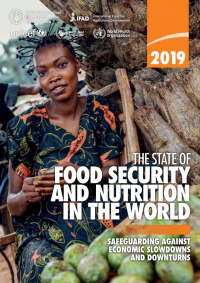UN report on “State of Food Security and Nutrition in the World” 2019 20/07/2019 – Posted in: Daily News
UN REPORT ON “STATE OF FOOD SECURITY AND NUTRITION IN THE WORLD” 2019
For: Preliminary & Mains
Topics covered: UN report of ‘State of Food Security and Nutrition in the World’ 2019, India Vs. Global scenario
News Flash
The report released by the UN Food and Agriculture Organization (FAO), estimated that 820 million people worldwide did not have enough to eat in 2018.
About the Report
This joint report is issued annually by the Food and Agriculture Organization of the United Nations, the International Fund for Agricultural Development, UNICEF, the World Food Programme and the World Health Organization.
- It presents the latest estimates on food insecurity, hunger, and malnutrition at the global and regional levels.
- The State of Food Security and Nutrition in the World 2019 also presents an in-depth analysis of the impacts of economic slowdowns and downturns on food security and nutrition.
Indian Scenario
- The number of obese adults in India has risen by a fourth in four years, from 24.1 million in 2012 to 32.8 million in 2016.
- India’s undernourished population has dropped from 253.9 million in 2004-06 to 194.4 million in 2016-18.
- Average GDP per capita growth rate between 1990 and 2017 in India is 4.5 percent.
- India’s poverty reduction is moving from 48.9 percent in 1987 to 21.2 percent in 2011 (13.4 percent in 2015, according to World Bank source).
Global Scenario
- 820 million people worldwide did not have enough to eat in 2018, up from 811 million in the previous year.
- The number of overweight individuals and obesity continue to increase in all regions.
- Maternal and child undernutrition contributes to 45 percent of deaths in children under five.
- Low birthweight estimates indicate that one in seven live births globally suffered from low birth weight in 2015.
- Estimates of exclusive breastfeeding reveal 41.6 percent of infants under six months being exclusively breastfed in 2018 compared with 37 percent in 2012.
- In 2018, Africa and Asia had the highest prevalence of exclusive breastfeeding.
- Hunger is on the rise in almost all African subregions, making Africa the region with the highest prevalence of undernourishment.
- Hunger is also slowly rising in Latin America and the Caribbean.
- Western Asia shows a continuous increase in Hunger since 2010, with more than 12 percent of its population undernourished today.
- Globally, the prevalence of stunting among children under five years is decreasing.
- Globally, the number of stunted children has decreased from 165.8 million in 2012 to 148.9 million in 2018.
- Average GDP per capita growth rate between 1990 and 2017 in China is 8.6 percent.
- China’s poverty rate declined from 88 percent in 1981 to 0.7 percent in 2015.
- In 2018, Africa and Asia bear the greatest share of all forms of malnutrition.
Need of the hour
- Major actions needed to safeguard food security and nutrition through economic and social policies.
- Steps also needed for social safety and ensuring universal access to health and education.
- Action needed to tackle inequalities at all levels through multisectoral policies making it possible to more sustainably avert food insecurity and malnutrition.
- The impact of economic slowdowns and downturns on food security and nutrition cannot be separated from the root causes of hunger and malnutrition: poverty, inequality, and marginalization.
Source: Indian Express
You can follow us on LinkedIn and on Instagram (Diligent IAS) for more updates related to IAS Preparation/ Study Material, Subscribe to our Facebook Page and Youtube Channel- Diligent IAS
Also, read more Daily News Updates
- Income Recognition and Asset Classification Norms
- Fairness for High-Skilled Immigrants Act of 2019
- Jalyukta Shivar Abhiyan
- The Population Regulation Bill, 2019

